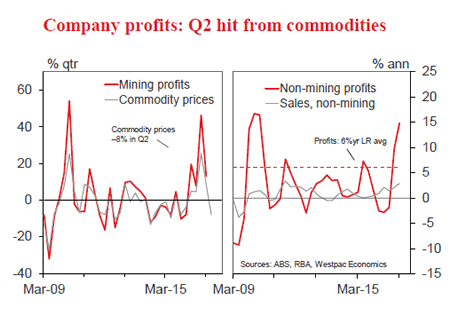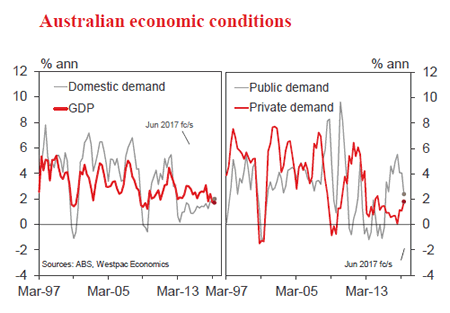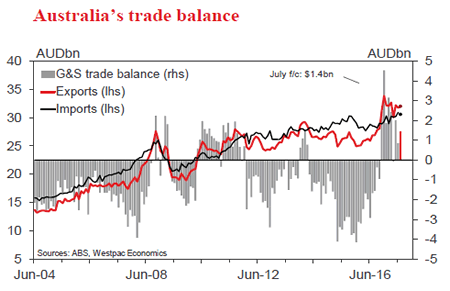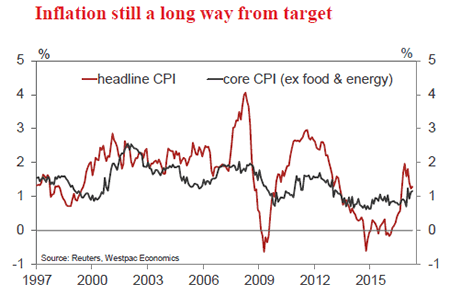Week beginning 4 September 2017
- RBA on hold – how our views contrast with the RBA.
- RBA policy announcement, speeches RBA Governor and Deputy Governor.
- Australia: GDP and partials, current account, retail, trade balance, housing finance.
- NZ: building work.
- China: CPI, PPI.
- Eur: ECB policy decision, final GDP, retail sales.
- US: Labor day, factory orders, numerous Fed speeches.
- Key economic & financial forecasts.
Information contained in this report was current as at 1 September 2017.
RBA on hold – how our views contrast with the RBA
The Reserve Bank Board next meets on September 5. The Board is certain to keep rates on hold. It is interesting to recall the key aspects of the Governor’s Statement following the last meeting on August 2:
- The RBA expects growth to be "around 3%" – in fact updated forecasts released three days later showed the Bank had retained its May forecasts of 3.25% in 2018 and 3.5% in 2019 (comfortably above trend of 2.75%).
- A pick-up in non-mining investment and wages growth is expected for 2018 and 2019.
- The Bank expects the unemployment rate to decline a little over the next couple of years.
- The higher exchange rate, and any further appreciation, is expected to contribute to reduced price pressures and a slower pick-up in activity. Note that despite those comments, there was no change in the Bank’s growth forecasts between May (AUD at USD 0.74) and August (AUD at USD 0.79). The AUD has remained in the USD 0.79-0.80 range since the last meeting.
- Growth in housing debt has been outpacing the slow growth in household incomes (an indirect reference to concerns around house prices).
The key themes around growth; investment; wages and inflation contrast with our own views.
This week, Westpac sponsored the ‘Breakfast with the Economists’ series with events in Sydney (1000 guests) and Melbourne (400 guests) featuring Paul Sheard (Chief Economist for Standard and Poor’s); myself; and several other economists in panel sessions.
I set out my opening remarks below:
Westpac expects the Australian economy to slow down in 2018 – to around a 2.5% growth rate in both 2018 and 2019, down from 2.8-3.0% in 2017.
This contrasts with ‘official’ forecasts from the RBA for 3.25% growth in 2018 (0.5% above trend) and 3.5% in 2019.
So where do we differ from the ‘official’ view?
Firstly, we expect the residential construction cycle will turn down from the second half of 2017 – high rise building approvals (around 50% of dwellings currently under construction) are already down 40% from their peak while detached approvals have only just started to recover from a soft patch this year.
Looking further out, it appears clear to us that the stresses around foreign investors and developers will further exacerbate the high rise construction cycle.
These investors and developers have been squeezed by tightening direct controls in China; higher state based stamp duties for foreign investors and other Government charges at both federal and state level; and reduced access to domestic funding.
Fortunately, there will be some offset to the housing construction downturn from stronger non-residential investment in offices and social building while state infrastructure investment, particularly in NSW, will also be a positive.
The second drag on growth should come from slower consumer related activity – wages growth is set to remain flat; spending associated with residential construction will slow; the wealth/ confidence effects resulting from rising house prices will dissipate; and heightened risk aversion will weigh on the consumer.
House price inflation will largely disappear over the course of 2018 as stretched affordability combines with tightening financial conditions (expect ongoing scrutiny from regulators with further ‘macro prudential’ policy tightening likely); and large increases in supply which will weigh on high rise markets, especially in Brisbane and Melbourne.
The unexpected recent strength in the AUD is already boosting services imports as more Australians look overseas for their holidays. The surge in foreign student enrolments in recent years may also ease.
Business investment is unlikely to lift much. A cautious consumer is one challenge. There is also likely to be intensifying political uncertainty which will see businesses quite reluctant to take risks in 2018 and 2019 until the next election is settled.
The job growth ‘catch-up’ we are currently seeing in Australia is also likely to reverse next year. The big job drivers in the economy – housing; consumer related spending; and services exports – will all be slowing.
We expect the unemployment rate, which is likely to settle around 5.5% in 2017, to move back towards 6% in 2018.
World growth and trade have surprised to the upside in 2017. Again, next year is likely to be a different story as China further tightens credit conditions and its economic growth slows from 6.7% in 2017 to 6.2% in 2018.
As President Xi consolidates his power at the upcoming National Congress (five of the seven Politburo Standing Committee members are expected to retire) he should cautiously resume a reform agenda. However, he is likely to continue to ‘tread lightly’ given no particular tight deadline. China’s debt issues are over-hyped by many global investors. Although corporate debt is around 170% of GDP, much of it is between Government banks and State owned Enterprise (i.e. government to government). Rebalancing this debt is a challenge for fiscal policy, but the cost is highly unlikely to be borne broadly by the private sector (either corporate or household).
The spillover effect of a slowing China will be sufficient to slow growth in our trading partners despite the US maintaining an above trend 2% pace in 2018.
That growth scenario will have clear implications for markets. The Reserve Bank will remain on hold next year, despite confident market pricing for the normalisation process to begin.
On the other hand, as financial conditions in the US have eased, and the FED becomes more flexible with its inflation target, the FED is likely to continue along its tightening path with three more hikes expected by end 2018.
At that point, the Australian cash rate (1.50%) will have fallen below the Federal funds rate (1.875%) and that unusual inversion will weigh on the AUD.
Confidence in the US dollar is also likely to be partially restored as the political turmoil seen this year eases and the administration surprises with tax reform; infrastructure investment; and a more liberal attitude to regulation across a range of industries.
As with last year, our forecasts are significantly out of line with market views but, as with last year, we are confident that markets will eventually move in the direction of these expectations.
Bill Evans, Chief Economist
Data wrap
Aus Jul dwelling approvals
- Dwelling approvals dipped 1.7% in July, the pull-back from June’s 11.7% jump much milder than expected (market forecast was -5%, Westpac -4%). Approvals are down 13.9% vs their high a year ago but over recent months have shown signs of stabilisation for high rise and firming across non high rise segments.
- The detail showed a flat month for private detached house approvals, the segment holding in a firm uptrend. Private unit approvals declined 6.7% but were coming off a 21% jump in June, the July read still 13% above the May level. The more granular detail points to a further small rise in high rise approvals (about 4%) which had been a big driver of the June gain (up about 15%mth). ‘Low rise’ or medium density dwelling approvals showed a more material reversal (down about 9% vs a 22% rise in June).
- Combined, non high rise approvals look to have pulled back about 3% from an 8.7% gain in June. This is broadly consistent with construction-related finance approvals which have shown a clear firming in recent months.
- By state, the lift in high rise approvals through June-July centred on NSW with this segment down across other states on a combined basis for the month. While volatility makes it hard to be definitive and its unclear whether the June-July lift in NSW will sustain, the broad picture across the major states still looks to be of high rise approvals levelling out after a sharp fall late last year and in early 2017.
- The state breakdown of non high rise approvals is more constructive with a clear firming trend in Vic, a more uneven pick up in NSW and Qld and stabilisation in WA.
- The value of renovation approvals declined 5.3% in July but was coming off a solid gain through May-June with a firm uptrend still intact (running at +1.8%mth, +5.1%yr).
- The value of non residential building approvals rose 2.4% in July but was also coming off a sold run in previous months with trend growth now a robust 3.1%mth, 14%yr. The lift is being driven by a surge in private sector office approvals which hit a new post-GFC monthly high in July. Recent gains in this segment have ben spread across both NSW and Vic.
- While a high-rise driven slowdown in dwelling activity remains assured near term, there are two key questions heading into 2018: 1) whether high rise takes another leg lower; and 2) whether the upturn apparent in non high rise segments in recent months continues. The risks to the first question look stacked to the downside particularly in the wake of the recent moves by Chinese authorities to curtail offshore investment by Chinese businesses. The second question remains more open – our prior is that a slowdown in the wider housing market and weak buyer sentiment will eventually see the recent rally fade. However, there are some positives relating to state government approval policies and perhaps some buyer and developer preference for lower density projects.
Aus Q2 construction work
- Construction work, having trended lower in recent years, associated with the deflating of the mining investment boom, spiked in the June quarter.
- In the June quarter 2017, construction work jumped 9.3%, a rise of $4.4bn, or 1.1% of GDP. That was well in excess of expectations (market median 1.0% and Westpac 1.0%).
- In the commentary associated with the release, the statistician was silent on this issue.
- We suspect that the spike is entirely due to the importation of a floating LNG platform, Prelude, which set sail for WA from a South Korean shipyard on June 28. The survey reports that private infrastructure work jumped 32.2% in the quarter, +$4.0bn and that construction work in WA leapt 55.6%, $4.1bn.
- This should have no net impact on GDP, with the rise in investment offset by a rise in imports.
- We had expected the ABS to amortise the value of the platform, spreading it over the time that it was constructed. This would see a relatively smooth rise in investment and in imports. This has been the approach in recent years and avoids these spikes – the approach taken back in the 1990s by the ABS.
- We are mindful that the import data, as reported in the monthly trade release, did not show a spike in June – hence our surprise today. We are now inclined to expect the ABS to revise the import data with the release of the Balance of Payments on Tuesday September 5, a day ahead of the National Accounts.
- In other detail, the standout is the upswing in public works, which is a notable growth engine as governments commit to new projects, particularly in transport. Public construction work grew by a further 4.7% in the quarter. Growth has been sustained at a brisk double digit pace, with the annual pace currently of 13.7% matching the 13.6% of a year ago.
- Private new home building activity may already be at a peak. Activity fell by 2.7% in Q1, revised up from -4.6%, with work disrupted by wet weather and flooding in NSW and Qld. In Q2, work declined by a further 0.8%. Over the past year, activity declined by 4%, with falls in this period reported for Victory, Qld and WA.
- Private renovation work managed a partial rebound, up 2.6%, after a 5.7% decline in Q1, to be 0.8% below a year ago.
- Private commercial building work consolidated in the quarter, inching 0.2% lower to be 1% below the level of a year ago. Going forward, work is set to advance, as indicated by the lift in approvals, with strength concentrated in Victoria and NSW, the two states experiencing above average population growth.
Aus Q2 private capex
- The latest ABS survey of private business CAPEX provided an update on actual spending for the June quarter 2017 and the 3rd estimate of plans for 2017/18, as well as the 7th and actual estimate of capex for 2016/17. The survey was conducted during July and August.
- The mining investment downturn has dominated total capex spending in recent years, a well as shaping the outlook. Recently, spending has consolidated has the mining downturn wanes and as spending by the non-mining sectors moves modestly higher.
- In the June quarter, total capex spending increased by 0.8%, exceeding expectations (mkt median 0.2% and Westpac -0.8%).
- The 0.8% gain follows a 0.9% rise in the March quarter and a decline of only 1.1% in the final quarter of 2017. Over the past year, capex declined by 3.0%, moderating from a 17% fall over the previous year.
- Capex by industry for Q2 was: services, +2.8%qtr, +3.7%yr; manufacturing, +1.4%qtr, +6.8%yr; and mining, -2.8%qtr, -15.2%yr.
- Equipment spending advanced by 2.7% in the quarter, exceeding expectations (Westpac f/c +0.6%). A lift in spending was reported across each of the three broad industry groups.
- Building & structures edged lower, -0.6%, again above expectations (Westpac f/c -1.8%). A further decline for the mining sector was largely offset by a modest rise across nonmining.
- Capex plans for 2017/18 have been upgraded, centred on services and commercial building.
- Estimate 3 for 2017/18 is $101.8bn, -3.6% vs Est 3 a year ago, a decline of $3.8bn. This is an improvement on the -6.4% for Est 2 on Est 2 reported three months earlier.
- Mining is the source of weakness for 2017/18, at -22%, -$9.2bn (unchanged from three months ago). Services was upgraded to +10% from +6%, so too manufacturing, to -2.6% from -12.4%.
- Calculations based on average realisation ratios (RRs) describe a similar picture. Est 3 implies a 3% fall in 2017/18, upgraded from -9% three months ago. By industry, results from average RR calculations are: mining -24%; services +9.5% vs +1.5% 3 months ago; and manufacturing -5%.
- Note, the capex survey has its limitations. The survey provides only partial coverage of total business investment, thereby overweighting the mining sector. Preliminary estimates (particularly Est 1 and Est 2) of capex plans are, by their nature, an inaccurate guide to the ultimate outcome – the extent of the error varies by asset, by industry and from year to year.
Aus Jul private credit
- Credit grew by 0.5% in July, matching the average for the June quarter and a step-up from the relatively soft 0.3% March quarter average as business emerges from a soft spot.
- Annual total credit growth is 5.3% currently, moderating from 6.0% a year earlier. Housing credit growth is 6.6%, unchanged from a year ago. Business credit grew by 4.2% over the past year, slowing from 6.3% a year earlier, reflecting some loss of appetite from both borrowers and lenders.
- Housing credit growth is likely to slow in response to the recent tightening of lending standards and out of cycle interest rate rises by commercial banks. As well, the boost from RBA rate cuts in May and August 2016 has faded. That said, more generous state government first home buyer initiatives, in effect from July, will provide a partial offset.
- There is tentative evidence that housing credit is beginning to slow. In July, housing credit expanded by 0.48%. This represents a step-down from a 0.55% average pace in the March quarter. It follows outcomes of 0.51% in April, a surprise 0.56% rise in May (most likely noise), and a 0.50% for June.
- On a quarterly basis, the tentative slowdown in housing credit is evident. The recent quarterly growth profile is: 6.1% annualised in Q2 2016; lifting to 6.4% in Q3; 6.6% in Q4; and 6.8% in 2017 Q1; then moderating to 6.5% in Q2; and printing at 5.9% annualised for the month of July 2017.
- The total value of housing finance having edged lower earlier this year appeared to have stabilised in June. While some month to month volatility is likely, we expect an emerging downtrend to be evident over coming months.
- As to investor housing credit, this grew by 0.41%mth in June and July, the softest monthly results since May 2016 – partly due to switching to the owner-occupier market. Annual growth for investors is 7.4% currently, while the 3 month annualised pace is 5.4%. For the owner-occupier segment, 3 month annualised credit growth has lifted to 6.9%, up from 5.5% at the start of the year.
- Turning to business, lending was volatile around a weaker trend over the past year or so. There was the dampening impact from heightened uncertainty around the July 2016 Federal election. This was followed by a burst of lending late in 2016 around infrastructure privatisation, contributing to a 1.1% jump in business credit in the month of December.
- In the business segment, over this period, there was an underlying loss of appetite from some borrowers (including deleveraging by the mining sector) and from some lenders (partly to reduce exposure to selected industries and to larger companies).
- More recently: the business mood has improved, mirroring global trends; commercial finance, while still volatile and not at a strong level, is off earlier lows; and business credit has advanced. Business credit increased by 0.5% in July, following gains of 0.4%, 0.3% and 0.8% for the three months April through to June.
- Business investment in the real economy by the non-mining sectors is advancing, but growth is currently relatively subdued, pointing to only modest growth in business credit.
New Zealand: Week ahead & Data Wrap
New Zealand is wrestling with a large and growing shortage of houses, with the shortfall centred squarely on Auckland. However, strong headwinds in the construction sector mean that building levels are likely to rise only gradually. This will challenge the strength of GDP growth over the coming year, and reinforces the case for the OCR staying on hold for an extended period.
Pressures in the Auckland housing market have continued to grow …
Back in 2009, we highlighted the emerging pressures in the Auckland housing market, and forecast that this would result in a strong pick up in construction activity. Eight years on, that’s exactly what we have seen. Residential construction has risen rapidly in recent years. That includes a sizeable lift in home building in Auckland.
But despite the lift in home building, pressures in the Auckland market haven’t gone away. In fact, they’ve gotten worse. Auckland’s population has risen by much more than expected, and home building has not kept pace. This has seen housing market tightness in Auckland rising to acute levels, reflected in a sharp increase in the average number of people per dwelling.
Looking ahead, Auckland’s population is set to continue growing at a rapid pace, with around 290,000 more people expected to settle in the region over the coming decade. Coming on top of the existing tightness in the Auckland housing market, this signals the need for a significant number of new homes in the region.
… however growing headwinds mean that residential construction is set to increase only gradually …
Despite the growing need for new building in Auckland, headwinds in the construction sector mean that we’re expecting only subdued growth in residential construction over the coming year. And recent developments indicate that growth in construction could be even softer than we’re assuming.
Several factors are providing a brake on residential construction. First is that developers are encountering increasing difficulties accessing finance. This is particularly important in Auckland, given the greater prevalence of medium to high-density housing developments, for which finance can be a significant hurdle.
At the same time, capacity in the construction sector has become stretched following strong increases in building activity over the past few years. This has resulted in building costs rising at a rapid pace, with the cost of building a new home in Auckland up around 40% over the past five years alone.
Importantly, this rise in building costs has come at the same time as the housing market in Auckland has been softening. Existing homes prices in Auckland are down 4% since the start of this year, and sales are at their lowest level since 2011. Many developers will be nervous about building into a slowing market.
These headwinds have sapped the momentum in Auckland’s construction sector, which showed through very clearly in this week’s July dwelling consent numbers. Consent issuance in Auckland has fallen 8% over the past three months (though that does include a pullback in the volatile multiples consent category). Looking at the longer-term trend, annual dwelling consent numbers have essentially flatlined at just over 10,000 since the start of this year. And the most recent figures actually point to some softening in building activity over the coming months. Importantly, dwelling consents numbers have plateaued at levels that are still well short of what’s needed to keep up with population growth. Consequently, it’s likely that tightness in the Auckland housing market will get worse before it gets better.
… reinforcing the case for the OCR remaining low for an extended period
Our forecasts for subdued residential construction are a key point of difference between us and the Reserve Bank. The RBNZ’s August policy assessment factored in continued strong increases in residential construction over the next few years. However, such increases look doubtful, especially with the slowdown in Auckland coming on top of the continued gradual wind-down of reconstruction work in Canterbury.
This subdued outlook for residential construction has important implications for economic conditions more generally. Construction activity was a key contributor to increases in GDP and employment in recent years, with spillovers to a number of associated industries. But with the momentum in the construction sector now waning, it’s likely that we’ll see more moderate GDP growth over the coming year. This will make it even harder for the RBNZ to generate the pick-up in domestic inflation that they have long pursued.
With the headwinds for growth increasing and a sustained pick-up in domestic inflation remaining elusive, the case for Official Cash Rate hikes in the near term looks thin. We expect that the OCR will remain on hold until late 2019. This is in contrast to financial markets pricing, which is consistent with OCR hikes from around September of next year.

Data previews
Aus Q2 profits
Sep 4, Last: 6.0%, WBC f/c: -4.0%
Mkt f/c: -4.0%, Range: -9.0% to 6.0%
- In the year to March 2017, company profits surged, jumping 40%, including a 6% rise in the quarter. The key was the rebound in commodities, up from the lows of late 2015, early 2016. Mining profits (36% of the total) more than doubled, +113%, over the period, while profits ex-mining rose 17%.
- However, in the June quarter, commodity prices stumbled and hence profits dipped. We anticipate the Business Indicators survey will report profits declined by 4%.
- Mining profits came off their highs in the quarter, with a potential double digit fall, a forecast -11.5%, associated with an 8% decline in global commodity prices.
- Non-mining profits were potentially constrained to only a small rise, a forecast +0.5%. Expanding sales were a plus in Q2 but margins remained under pressure, with a lack of pricing power at a time of rising costs.

Aus Q2 inventories
Sep 4, Last: 1.2%, WBC f/c: 0.2%
Mkt f/c: 0.3%, Range: -0.7% to 1.0%
- Inventories were a likely swing factor over the first half of 2017, centred on mining.
- In Q1, inventories rose 1.2%, +$1.8bn, the largest rise since March 2012, and added 0.4ppts to quarterly growth. There was a $1.0bn build-up on mining inventories as some rail links to the ports were closed due to flooding.
- In Q2, we expect total inventories to increase by only 0.2%, subtracting 0.4ppts from growth. The headline figure is constrained by a likely drawing down of mining inventories as rail links re-opened.
- Total inventories ex mining and ex manufacturing (where there is a structural decline) are forecast to rise by a strong 1.5% in Q2, matching the outcome for Q1. Firms across the non-mining economy are expanding inventories to meet rising sales.

Aus Q2 current account, AUDbn
Sep 5, Last: -3.1, WBC f/c: -9.0
Mkt f/c: -7.4, Range: -9.5 to -1.0
- Australia’s current account deficit narrowed to only $3.3bn in Q1, 0.7% of GDP. That was the smallest deficit as a share of the economy since the end of 1979. The trade surplus was 2.1% of GDP, the largest since mid-1973.
- In Q2, the current account widened to a forecast $9.0bn as the trade position deteriorated on a dip in export prices as commodity prices eased.
- The trade balance was $3.3bn in Q2, a $5.9bn deterioration on Q1 (or, after revisions, a deterioration of $4.0bn). Export earnings declined by around 3%, dented by lower prices, while the import bill increased by around 2%. The terms of trade declined by an estimated 5%.
- The net income deficit is expected to hold around the Q1 level of $12.35bn, which represented a $5bn deterioration on six months earlier, as foreign investors in the mining sector enjoyed stronger returns.

Aus Q2 net exports, ppts cont’n
Sep 5, Last: -0.7, WBC f/c: 0.10
Mkt f/c: -0.05, Range: -0.60 to 0.10
- Net exports, like inventories, were a swing factor over the first half of 2017 – but moving in the opposite direction.
- In Q1, net exports subtracted a hefty 0.7ppts from growth as exports fell by 1.6% and imports increased by 1.6%, to meet rising demand. The key surprise was that resource exports slumped 4.6%, subtracting 2.5ppts of total exports, hit by bad weather and mechanical disruptions.
- In Q2, net exports are expected to be broadly neutral, at +0.1ppt.
- Export volumes rose an estimated 2.2%, with gains in iron ore, LNG, services and manufacturing outweighing a fall in coal. Coal shipments are set to rebound in Q3 with a return to more normal conditions.
- Import volumes advanced a further 1.9% we estimate, with broad based strength (excluding gold).

Aus Q2 public demand
Sep 5, Last: 0.5%, WBC f/c: 1.3%
- Public demand grew by an above trend pace in 2015 and 2016, 4.6% and 4.1%, respectively. This followed four years of weakness.
- An upswing in public investment is underway, lifting from recent lows, as governments commit to additional projects now that earlier fiscal pressures at the state level have receded.
- In Q1, public demand surprised to the down side, with a gain of only 0.5%, constrained by a dip in investment.
- In Q2, the upswing in public investment resumed. Overall public demand is expected to increase by 1.3% in the quarter, adding 0.3ppts to growth.

Aus RBA policy decision
Sep 5, Last: 1.50%, WBC f/c: 1.50%
Mkt f/c: 1.50%, Range: 1.50% to 1.50%
- The RBA is certain to leave rates unchanged again at its September meeting. The Bank has left the cash rate unchanged since August last year.
- Over the past year, economic growth has been patchy, core inflation is below the target band, there is significant slack in the labour market and wages growth is at historic lows.
- With a number of these trends likely to persist, we expect rates to remain on hold throughout 2017 and 2018. However, market pricing is for one rate hike by the second half of 2018.
- The 2018 outlook is critical to the rates debate. The RBA’s central case forecast is for growth to accelerate to be above trend in 2018 and into 2019. We are less convinced, expecting growth to slow to below trend in 2018.
- See page 2 for a full discussion of the outlook, contrasting our view with that of the RBA.

Aus Q2 GDP
Sep 6, Last: 0.3%qtr, 1.7%yr; WBC f/c: 0.7%qtr, 1.7%yr
Mkt f/c: 0.7%, Range: 0.5% to 1.0%
- The Australian economy gained momentum in Q2. Real GDP grew by a forecast 0.7%, after a 0.3%, comprised of: domestic demand +1.0%; inventories -0.4ppts; and net exports +0.1ppts.
- Conditions rebounded from recent weather disruptions (except coal shipments in April). Public investment and business investment increased, with the waning of the mining investment downturn. As well, global growth has improved.
- There was a hiring burst in the period, with employment up 0.9%, including full-time +1.1%, and hours worked rose 1.2%. This corrects for undue employment weakness in 2016.
- Consumers spent more freely in the period, a forecast +1.0%, twice the Q1 pace. Household incomes were supported by employment strength but wages growth remains weak. Home building activity was little changed in the quarter.
- For more detail, see our GDP preview.

Aus Jul retail trade
Sep 7, Last: 0.3%, WBC f/c: 0.2%
Mkt f/c: 0.2%, Range: 0.1% to 0.6%
- Recent months have seen retail sales recover from weather disruptions at the start of the year, with a 1% rise in Apr followed by a 0.6% gain in May and a 0.3% gain in June. Recall that the start of 2017 saw an abnormally high number of heatwave and wet weather days across the eastern capital cities with severe weather from Cyclone Debbie also impacting in late March.
- The rebound in momentum is now fading. Meanwhile the backdrop in terms of consumer sentiment remains shaky with signs family finances came under renewed pressure through mid 2017 with mortgage rate increases and continued concerns around housing markets more than offsetting an improvement in labour markets. Aggressive price discounting remains a factor as well. On balance, we expect July to post a weak 0.2% gain for monthly sales.

Aus Jul trade balance, AUDbn
Sep 7, Last: 0.9, WBC f/c: 1.4
Mkt f/c: 0.9, Range: 0.2 to 3.0
- Australia’s trade balance has been in surplus in seven of the past eight months.
- For July, we expect the surplus to widen from $0.86bn to $1.4bn, an improvement of $550mn.
- Export earnings are forecast to rise by 0.8%, $250mn. Gains in iron ore (higher prices) and coal (volumes) offset slippage in LNG (disruptions) and gold (off a high base).
- The import bill declines by an anticipated 1%, $300mn, as prices fall in association with a stronger currency. The Australian dollar made solid gains in the month, up 3% against the US dollar and +2.5% on a TWI weighted basis.

Aus Jul housing finance (no.)
Sep 8, Last: 0.5%, WBC f/c: 1.5%
Mkt f/c: 1.0%, Range: -4.0% to 2.5%
- The number of housing finance approvals to owner occupiers edged up 0.5% in June but with the detail more positive, approvals ex-refi up 1.9% and investor loans and constructionrelated loans also posting solid rises. Note that the first round of mortgage interest rate rises associated with macro prudential tightening measures came through in late March with a second round of changes only coming in late June.
- The July update should provide more clues as to the impact of these measures although its still likely to be too early for June rate moves to impact. Industry data points to a solid lift in owner occupier loans in the July month, some of which may be indirect spillover effects of higher rates for investor loans. We expect approvals to be up 1.5% but the focus will be on investor loans.

NZ Q2 building work put in place
Sept 5, Last: -3.5%, Westpac f/c: +4.5, Mkt f/c: 1.6%
- Following an unexpected fall in March, we expect the upcoming building work report will show that construction activity rebounded in the June quarter.
- Much of the weakness seen earlier in the year related to non-residential projects, which can be lumpy on a quarterto- quarter basis. With a large amount of construction activity occurring nationwide, we expect a solid rise in non-residential building in June.
- Residential construction is also expected to rise modestly. However, rising building costs, stretched capacity in the building sector, and tighter bank lending standards for property developers are all providing some brake on how quickly building activity ramps up.

ECB Sep policy meeting
Sep 7, deposit rate -0.40%
- President Draghi put off speaking on the topic of monetary policy at the Jackson Hole Symposium, instead choosing to focus on the long-term concerns of confidence and productivity. Before and after that engagement, the Euro continued to rally past USD1.20.
- To our mind, the ECB Governing Council is not overly concerned about the current level of the currency, but a further jolt higher is certainly not desired.
- Come September, the market will be focused on guidance on a 2018 taper and forecast revisions. To hold off a higher Euro, the Council needs to emphasise that the taper process will be slow and that rates won’t rise until well after it is completed. Note it is not a given that hard detail on the taper will be provided in September; the Council may wait until October or December.













